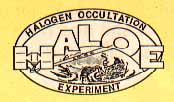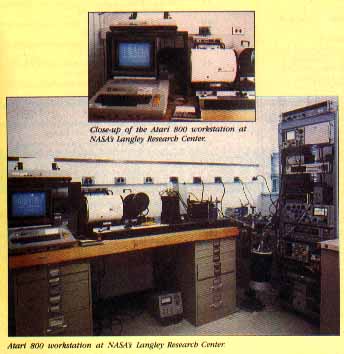
Space-Age Atari
NASA research 8-bit style
By George Lockard

In the highly technological and scientific environment of NASA's Langley Research Center at Hampton, Virginia, we use an expanded Atari 8-bit computer system daily.
The Atari computer system was surplus equipment, and although it had some age on it when I acquired it, the system was still in fine working order and has performed well since. I have used Atari 8-bit computer systems in several professional applications instead of the "Big" machines, at considerable savings, and they have performed extremely well.
Langley is assembling and testing the Halogen Occulation Experiment(HALOE) satellite instrument for flight on the Upper Atmospheric Research Satellite (UARS) to be launched by late 1991. HALOE will measure and monitor seven gases which are critical to understanding atmospheric chemistry.
These gases are measured by optical detectors. The detectors have to be tested and characterized extremely well. One of the tests performed is the measurement of the linearity of the detector's response to various signals. It is in this test set-up that the Atari system is utilized.
The system hardware consists of an Atari 800 with an Axlon 128K memory expansion board, an Indus disk drive, an Axlon IMP printer with printer interface and a Panasonic color computer monitor. The system software consists of only a few commercial software products, mainly Letter Perfect, Data Perfect and B/Graph. Most of the software that is used is custom written to meet the System requirements.
The Atari computer is put to use in several ways. Some programs were written to generate tables and charts to be used in determining the equipment settings for the required test conditions, while special programs have been developed to enable it to perform data reduction and analysis of the measured data. This information, along with the measured data, is loaded into the main program which then compares the test results with the test requirements, to determine if the detectors met the spaceflight specifications.
Programmed comments are displayed on the screen to inform the operator of various conditions of the test. All of the computational and measured results are also available to the operator for review. When the operator is satisified, the general housekeeping information, along with operator comments, is then recorded.
Formatted calibration/test result sheets are printed out and the results are saved, since we are required to keep all of the test data and results until UARS becomes inoperative. Status reports with graphs are generated using the Atari's word processing capabilities. These reports are distributed throughout NASA for review by the appropriate responsible individuals.
Atari 8-bit computers such as the 130XE and the 800 series may not have the speed, memory and graphics resolution of the more powerful and expensive 16 and 32 bit computers around today, but they should not be overlooked as the low-cost and highly efficient computers that they are. I have found that Atari lives up to its slogan, "Power without the Price."
George Eugens Lockard is an Engineering Technician who has a 15-year back- ground working with electronics at NASA.